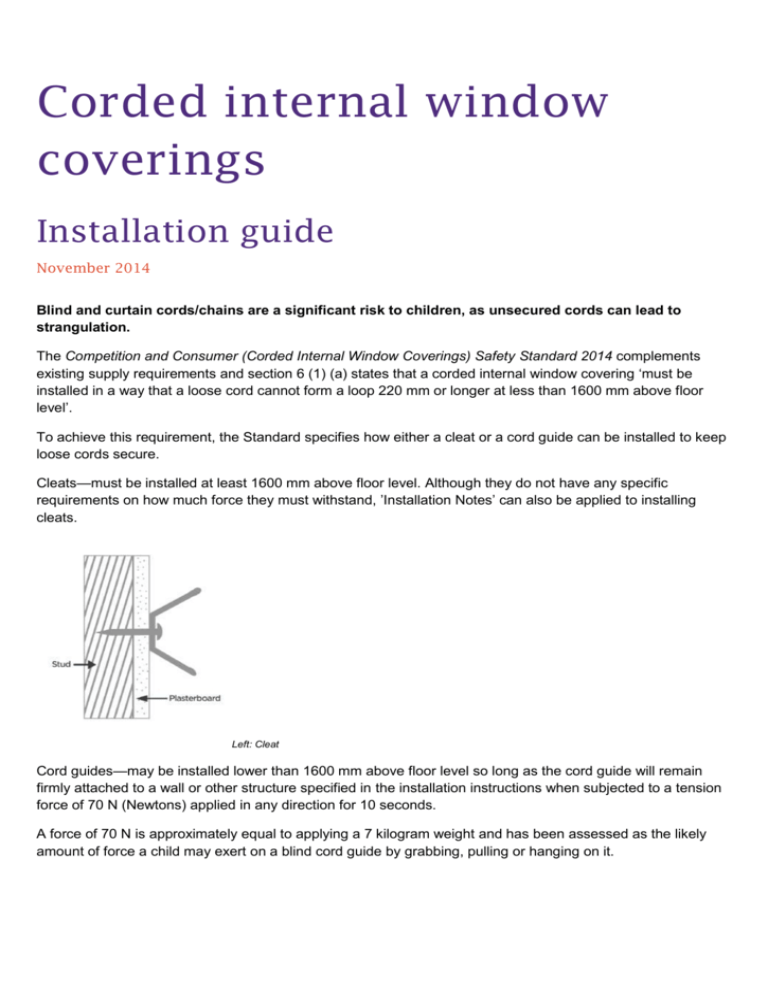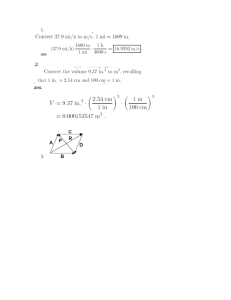Corded internal window coverings
advertisement

Corded internal window coverings Installation guide November 2014 Blind and curtain cords/chains are a significant risk to children, as unsecured cords can lead to strangulation. The Competition and Consumer (Corded Internal Window Coverings) Safety Standard 2014 complements existing supply requirements and section 6 (1) (a) states that a corded internal window covering ‘must be installed in a way that a loose cord cannot form a loop 220 mm or longer at less than 1600 mm above floor level’. To achieve this requirement, the Standard specifies how either a cleat or a cord guide can be installed to keep loose cords secure. Cleats—must be installed at least 1600 mm above floor level. Although they do not have any specific requirements on how much force they must withstand, ’Installation Notes’ can also be applied to installing cleats. Left: Cleat Cord guides—may be installed lower than 1600 mm above floor level so long as the cord guide will remain firmly attached to a wall or other structure specified in the installation instructions when subjected to a tension force of 70 N (Newtons) applied in any direction for 10 seconds. A force of 70 N is approximately equal to applying a 7 kilogram weight and has been assessed as the likely amount of force a child may exert on a blind cord guide by grabbing, pulling or hanging on it. Left: Cord guide This guide provides some screw fixing options which, if correctly installed in accordance with this guide, are highly likely to withstand a 70 N force for 10 seconds, and meet legal requirements. Cleats and cord guides Always choose to install new blinds and curtains that are compliant with the national mandatory standard and utilise the cleats or cord guides they provide. Where cleats or cord guides are required for existing curtain or blind cords/chains, opt for steel or metal devices. Plastic cleats or cord guides may become brittle or deteriorate over time due to factors such as sun exposure, and therefore will be more susceptible to failure when exposed to force. Where possible, opt for devices that require more than one screw to be used, for greater strength. Installation notes Always read and follow the manufacturer’s installation instructions. If you are unsure of the substrate to which you are fixing, seek a professional opinion. Ensure that the substrate being fixed to is in good condition. Do not fix to surfaces that are rotted, waterlogged, burnt, brittle, or otherwise damaged. When installing the device, install using either a drill or screwdriver with the appropriate shaped head. Always insert the screws into the holes specially provided within the device—do not create your own screw holes or screw through areas of the device that do not have screw holes. Always use the correct number of screw fixings as recommended by the manufacturer. Always use quality hardware. Cleats must be installed more than 1600 mm above floor level. Cord guides may be installed less than 1600 mm above floor level, however you must ensure the cord is tensioned to prevent it forming a loop of 220 mm or longer. Fixing methods Table 1 outlines acceptable screw fixings for substrates most commonly found in domestic dwellings. Screws are the most appropriate method of fixing in terms of reliability and availability. Unacceptable Fixing Materials The following fixing methods are unacceptable as they do not provide adequate resistance: Nails Staples Double or single-sided tape Adhesives. Substrate 10–13 mm plasterboard lining Fixing Type 20 mm min Pan head selfembedment into drilling screw timber stud behind or Minimum as per Length: 40 manufacturer’s recommendations mm Minimum Gauge: 7 Installation instructions* 1. Measure the total thickness of the materials to be fixed to 2. Select a screw length long enough to achieve the minimum embedment required 3. Use a power drill with a #2 Phillips bit or equivalent screw driver (or as recommended by manufacturer) 20 mm min embedment into Note: when fixing to plasterboard linings, metal stud behind or the screw must embed into a timber stud as per in order to achieve acceptable resistance. manufacturer’s Fixing to plasterboard linings only is recommendations unacceptable. A stud-finder can be used Pan head selfdrilling screw Minimum Length: 40 mm to identify the location of the studs within a plasterboard lined wall Minimum Gauge: 7 Substrate Fixing Type Installation instructions* Pan head selfdrilling screw 1. Measure the total thickness of the materials to be fixed to 11–18 mm pine or MDF architrave Wall tile on fibre cement lining 11 mm min embedment or as per manufacturer’s recommendations For walls with clear space/cavity behind Use only as per manufacturer’s recommendations Minimum Length: 20 mm Minimum Gauge: 6 Pan head cavity fastener Minimum Length: 50 mm 4. Put screw onto drive bit and place at 90 degrees to fastening position to ensure screw enters the wall straight 5. Drive screw into wall until head is flush with the surface of the cord guide. Take care not to overtighten the screw and lessen its fixing as this may strip the wall material around the threads of the screw and lessen its resistance 2. Installation as per manufacturer’s directions 1. Measure the total thickness of the materials to be fixed to 2. Installation as per manufacturer’s directions Brick/block masonry 20-25 mm min embedment or as per manufacturer’s recommendations (For masonry walls with plasterboard lining, embedment must be into masonry material) Note: Caution must be exercised when drilling into masonry to not crack or break away the surface of the material. If the surface area is compromised, the resistance of the fixing may be affected. If this occurs, it is recommended that the fitting be relocated to a new area a minimum of 100 mm from the original compromised fixing point Round head expanding anchor Minimum Length: 25 mm Screw fixing with nylon star plug Minimum Screw Length: 35 mm 1. Measure the total thickness of the materials to be fixed to 2. Installation as per manufacturer’s directions 1. Measure the total thickness of the materials to be fixed to 2. Use a power drill with a 7 mm drill bit and drill a hole. Hold the drill at 90 degrees to wall surface to ensure hole is straight Minimum Screw Gauge: 8 3. Insert plug (use hammer if required) Minimum Plug Length: 35 mm 4. Fix cleat to wall by inserting screw into wall plug and tightening using power drill with #2 Phillips bit Minimum Plug Diameter: 7 mm Final installation summary Cleats may not be installed lower than 1600 mm above floor level. Cord guides must be installed so that a loose cord cannot form a loop of 220 mm or longer at a height of less than 1600 mm above floor level. If the final installation of the cord guide is below 1600 mm above floor level, the cord must be tensioned to prevent such a loop from forming. Any cord guide installed lower than 1600 mm above floor level must be capable of withstanding a tension force of 70 N applied in any direction for 10 seconds. If you are uncertain of the cord guide’s capacity to meet the standard, further testing is advised by a qualified professional. Disclaimer This guide is intended to provide simple instructions on methods for fixing cord guides and/or cleats to resist a 70 N force. The information in this guide is for general use and does not constitute legal or professional advice. Users should ensure the final installation is checked by a professional to ensure it complies with all relevant Australian Standards. The ACCC disclaims any liability howsoever arising from the use of this guide. Australian Competition and Consumer Commission 23 Marcus Clarke Street, Canberra, Australian Capital Territory 2601 © Commonwealth of Australia 2014 ACCC 11/14 Important notice The information in this publication is for general guidance only. It does not constitute legal or other professional advice, and should not be relied on as a statement of the law in any jurisdiction. Because it is intended only as a general guide, it may contain generalisations. You should obtain professional advice if you have any specific concern. The ACCC has made every reasonable effort to provide current and accurate information, but it does not make any guarantees regarding the accuracy, currency or completeness of that information.







